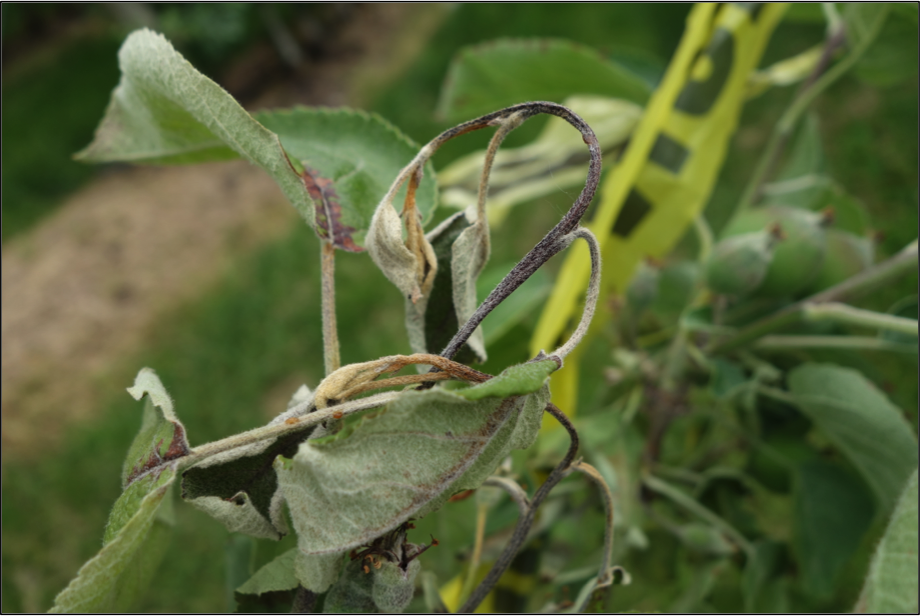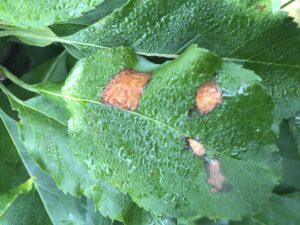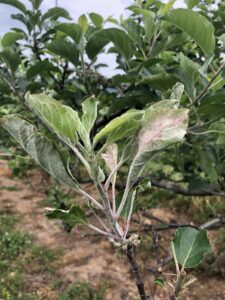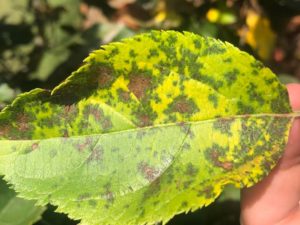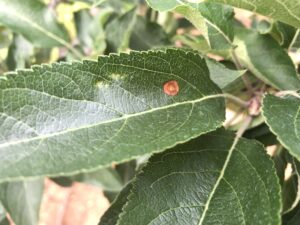Apple Disease Update: Week of May 4, 2025
go.ncsu.edu/readext?1071045
en Español / em Português
El inglés es el idioma de control de esta página. En la medida en que haya algún conflicto entre la traducción al inglés y la traducción, el inglés prevalece.
Al hacer clic en el enlace de traducción se activa un servicio de traducción gratuito para convertir la página al español. Al igual que con cualquier traducción por Internet, la conversión no es sensible al contexto y puede que no traduzca el texto en su significado original. NC State Extension no garantiza la exactitud del texto traducido. Por favor, tenga en cuenta que algunas aplicaciones y/o servicios pueden no funcionar como se espera cuando se traducen.
Português
Inglês é o idioma de controle desta página. Na medida que haja algum conflito entre o texto original em Inglês e a tradução, o Inglês prevalece.
Ao clicar no link de tradução, um serviço gratuito de tradução será ativado para converter a página para o Português. Como em qualquer tradução pela internet, a conversão não é sensivel ao contexto e pode não ocorrer a tradução para o significado orginal. O serviço de Extensão da Carolina do Norte (NC State Extension) não garante a exatidão do texto traduzido. Por favor, observe que algumas funções ou serviços podem não funcionar como esperado após a tradução.
English
English is the controlling language of this page. To the extent there is any conflict between the English text and the translation, English controls.
Clicking on the translation link activates a free translation service to convert the page to Spanish. As with any Internet translation, the conversion is not context-sensitive and may not translate the text to its original meaning. NC State Extension does not guarantee the accuracy of the translated text. Please note that some applications and/or services may not function as expected when translated.
Collapse ▲As of May the 4th, the forecast looks to be on our side for Western NC, with conditions not being very conducive for phytopathogen infection or disease symptom development. That said, please don’t keep the sprayers parked as it’s important to keep the tissue covered with a fungicide this time of year. Despite the cooler temperatures and low chance of rain, those that have a few years of experience growing apples in the mountains know leaf wetness and dew are regular foes. In all of our blocks at the MHCREC with the exception of ‘Red Delicious’, we are spraying 3 lb/A Manzate Pro-Stick (or a similar alternative such as Roper DF). We put Merivon in last week and given the forecast and its residual activity I don’t think it’s necessary two weeks in a row. For “Red Delicious’ we are going in with 3 lb Captan 80 WDG to tackle Alternaria leaf spot. Here are some more specific considerations:
- If you applied Merivon or Aprovia last week with mancozeb, you should be fine with mancozeb this week when it comes to bitter rot and GLS control. If you spray later in the week, check the forecast for the first half of next week and make sure the rain probability remains fairly low. If the likelihood of rain increases, consider adding Merivon to the tank (if Aprovia, Manzate alone, or Omega was applied last week) or Aprovia to the tank (if Omega, Merivon, or Manzate alone was applied last week).
- Scout for primary powdery mildew. If you are seeing stunted shoots that are covered in white/silver colored spores, you may want to fungicide with good efficacy against the disease. Gatten is a powdery mildew specific fungicide with a unique FRAC group (U13). Some of the older DMI (FRAC 3) fungicides such as Rhyme, Procure, and Rally 40WSP, also pack a punch against mildew in apple. In general, strobilurins have performed great in our mildew trials, and many SDHI (FRAC 7) fungicides have demonstrated good activity. However, I would refrain from spraying these fungicides just for the sake of powdery mildew.
- Continue to keep Marssonina on your mind. Now is the time to target primary inoculum for this disease. In addition to mancozeb, consider including Tesaris or Cevya as both have performed excellent in our trials. In general, the strobilurins, most SDHIs (FRAC 7) (with the exception of Tesaris), and older DMI (FRAC 3) products have not shown high efficacy in our MLB trials at the MHCREC. In cultivars or block where you had Marssonina leaf blotch (MLB) issues last year, make sure to target these blocks with specific MLB fungicides this year. As any FYI, half of Merivon is Tesaris!
- As discussed last week, mancozeb is not very effective against Alternaria in apples. For ‘Red Delicious’ swap 3 lb/A Captan 80WDG for mancozeb this week, or apply 2.5 lb/A Captan 80 WDG plus 3 lb/A manzate. If you didn’t apply a strobilurin (FRAC 11) to your ‘Reds’ last week, you may want to get one in the tank this week to target the primary inoculum of Alternaria leaf spot.
Lastly this week, I want to continue to harp on the importance of prohexadione calcium (Kudos) for shoot blight management. There were a few shoot blight outbreaks that I was alerted to in Polk County-either from blossom blight infections or from damage to young shoot leaves which created a wound for the fire blight bacterium to enter. Regardless, well timed Kudos applications should provide significant reduction in shoot blight incidence and severity through the following mechanisms:
1. Kudos slows or shuts down shoot elongation during the period of time that infection by the fire blight pathogen is of the most concern in apple orchards. Erwinia amylovora can enter the plant through micro-wounds on young, unopened leaves on expanding shoots. In fact the way we inoculate trees for shoot blight trials is to dip scissors in a suspension of E. amylovora and then cutting through the middle of the three newest leaves. In NC, growth on terminal shoots that were treated with Kudos, tended to “catch-up” by the end of the season.
2. Kudos can thicken parenchyma cell walls in leaves. These thickened cell walls actually serve as a barrier to E. amylovora and prevent the pathogen from injecting proteins needed for virulence into the plant.
3. Kudos can induce natural host defenses thus preparing the host for attack against a pathogen.
While it’s relatively late for Kudos applications in Henderson County, I would still consider it-particularly in later blooming cultivars. In my blossom blight trials at the MHCREC, we are still seeing blossom blight infections popping up following inoculation a few weeks ago. Based on research by both Tom Kon’s program and mine in Mills River, I’d consider the following:
- Orchards 3rd or 4th and older (regardless of rootstock) 12 oz/100 gal Kudos ASAP and then 10 days later
- Orchards younger than 3rd or 4th leaf: 3 to 6 oz/100 gal Kudos OR 2 to 3 oz/100 gal Kudos + Actigard (1 to 2 oz/A)
- For both options make sure to read the label regarding tank mixing
If you have an active fire blight infection here are my notes from last week’s post:
If you notice an outbreak of blossom blight or shoot blight consider taking the following steps:
- Try to avoid pruning first thing in the morning as dew and bacterial ooze might be present which can lead to spread of the pathogen causing new infection
- Consider applying a 12 oz/100 gal rate of Kudos to slow down systemic movement of the pathogen. This should also help to prevent additional infections. Make sure to add a water conditioner and a surfactant such as Regulaid or ChemWett.
- After applying Kudos or Apogee, wait until at least the REI is up (12 hours), prune out infections at least 12 inches from the advancing symptom margin
- Follow up with a streptomycin application. Consider the 200 ppm rate and including Regulaid or similar adjuvant.
I’ve also been getting some questions about calcium for GLS and bitter rot control. In next week’s post I plan to summarize our preliminary research in ‘Gala’ to help you make a more informed decision regarding calcium rate for disease control.



